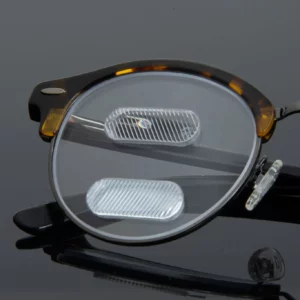Homonymous Hemianopia
Normal Vision
Hemianopic Vision
What Is Homonymous Hemianopia?
Homonymous hemianopia (also known as hemianopsia) is a specific type of visual field loss that presents as blindness in the same half of the visual field in both eyes and significantly impacts a person's visual awareness and daily functioning. This condition is most often the result of a stroke or brain injury in the occipital lobe and is not the result of an eye problem. It's due to damage in the main visual pathways of the brain.
What It Feels Like to Live with Homonymous Hemianopia
Basically, when someone suffers from homonymous hemianopia, they only see one half of their visual world. For instance, they might see only the right side of faces, words, or objects.
To give you a better understanding, imagine watching TV but only seeing the left half of the screen, or going to a baseball game and only seeing the right half of the field. Now imagine that the missing information in your visual field isn’t some kind of black spot that you’re constantly aware of, it’s simply not there.
Now imagine what it’s like to walk through a crowd of people without your full field of vision and no real awareness that anything is missing. That's what life is like with homonymous hemianopia.
As you can imagine, homonymous hemianopia can significantly impact a person’s safety and even ability to perform daily tasks. Simply walking to the store, they’re faced with any number of trip or collision hazards.
Common Causes
While the most common cause for homonymous hemianopia is stroke, other causes include Traumatic Brain Injury (TBI), brain tumors, complications from brain surgery, and even Multiple Sclerosis (though that is less common).
Historical Treatments
Historically, homonymous hemianopia was treated with either spotting prisms, yoked spotting prisms, or yoked prisms. The result of these treatments is, generally, a slight field expansion while sacrificing other pieces of the visual field (new blind spots) or double vision.
Another (and much better) option is to use peripheral prisms, such as the Peli Lens™. Peripheral prisms like the Peli Lens™ provide the patient with up to and over 30 degrees of visual field expansion with no new blind spots or double vision.
Read more about the other treatment options for Homonymous Hemianopia and learn why we only recommend the Peli Lens™.
How We Help – The Peli Lens
The Peli Lens™ is a proprietary lens that uses peripheral prisms to help patients with peripheral vision loss attributed to homonymous hemianopia. Created by Dr. Eli Peli, it works by expanding a hemianopic patient’s awareness of their blind side by over 30 degrees, thereby alerting the patient of movement in their blind side so they can better detect obstacles and navigate around them.
Because they are only worn to increase mobility or perform certain tasks, the Peli Lens™ is generally attached to a patient’s blind side lens using our patented SLAM (single lens attached by magnets) technology. This is the most popular option as it allows the patient to easily add or remove the Peli Lens™ to their glasses. They can also be built into a fitover that’s worn over a patient’s glasses.
We also offer a Peli Evaluation Kit (PEK) that allows you to trial temporary peripheral prisms with a patient in your office before ordering the full powered prisms.
Learn How the Peli Lens™ works.
Or, if you already know, order a PEK or call us to order.



